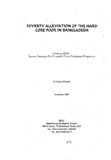| dc.contributor.author | Ahmed, Dilruba | |
| dc.date.accessioned | 2019-11-18T05:51:53Z | |
| dc.date.available | 2019-11-18T05:51:53Z | |
| dc.date.issued | 1997-11 | |
| dc.identifier.citation | Ahmed, D. (1997, November). Poverty alleviation of the hard core poor in Bangladesh. Research Reports (1997): Economic Studies, Vol - XII, 175–233. | en_US |
| dc.identifier.uri | http://hdl.handle.net/10361/12996 | |
| dc.description.abstract | BRAC launched IGVGD Programme to improve the condition of the poorest women covered
by Vulnerable Groups Development (VGO) Programme. In this context high yielding variety
(HYV) poultry birds rearing was introduced as an income generating activity for increasing the
economic and nutritional well-being of the IGVGD participants. To sustain the process of development
of the participants, BRAC merged IGVGD with Rural Development Programme
(RDP). It is found that RDP could not include many of the very poor and disadvantaged
women. The objectives of the study were to :
1. investigate the changes brought about by the Programme in its participant households;
2. assess the extent to which the Programme represented the 'poorest of the poor' ; and
3. know the reasons for drop out of the participants from the IGVGD.
The study locations were selected from both IGVGD and RDP areas, viz., Kishorgonj, Karimgonj,
Tangail and Bhuapur. Both IGVGO and RDP had the IGVGO Poultry Porgramme
(IGVGDPP). Data were collected from the participants in four of the HYV poultry rearing activities
of IGVGDPP, viz., chick rearers, key rearers, feed sellers and egg collectors. The study
subjects were the ex-VGD, drop out and inactive members. Ex-VGOs were those who were no
more entitled to wheat ration as their ration cycle had already completed. Dropout members
were those who were no more functionally related with the poultry rearing Programme and had
· completed the repayment of loan installments. At present they were not the members of BRAC
Programme at all. Inactive members were those who were no more functionally related with
the poultry rearing Programme but had not yet completed the repayment of loan installments.
The study focused mainly on the 1994-96 cycle. The current VGO members of 1 996-98 cycle
were included as control group. Current-VGOs were those who enjoyed the wheat ration at
present. Five percent of the key rearers were randomly selected while the others were purposively
selected since they were few in number from the study area. The study interviewed
493 respondents including 360 current and ex VGDs and 133 drop out and inactive members.
The study presents its main findings in three chapters. | en_US |
| dc.language.iso | en | en_US |
| dc.publisher | BRAC | en_US |
| dc.subject | Poverty alleviation | en_US |
| dc.subject | Hard core poor | en_US |
| dc.subject | BRAC | en_US |
| dc.subject.lcsh | Economic development--Bangladesh. | |
| dc.subject.lcsh | Rural development--Bangladesh. | |
| dc.title | Poverty alleviation of the hard core poor in Bangladesh | en_US |
| dc.type | Research report | en_US |

